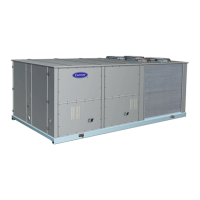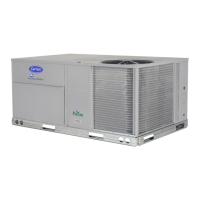14
THERMOSTATIC EXPANSION VALVE (TXV)
All 48LC units have a factory-installed nonadjustable thermostatic
expansion valve (TXV). The TXV will be a bi-flow, bleed port ex-
pansion valve with an external equalizer. TXVs are specifically
designed to operate with Puron or R-22 refrigerant, use only facto-
ry authorized TXVs. Do not interchange Puron and R-22 TXVs.
TXV Operation
The TXV is a metering device that is used in air conditioning and
heat pump systems to adjust to changing load conditions by main-
taining a preset superheat temperature at the outlet of the evapora-
tor coil.
REPLACING TXV
1. Recover refrigerant.
2. Remove TXV support clamp using a
5
/
l6
-in. nut driver.
3. Remove TXV using a backup wrench on connections to pre-
vent damage to tubing.
4. Remove equalizer tube from suction line of coil. Use file or
tubing cutter to cut brazed equalizer line approximately 2 in.
above suction tube.
5. Remove bulb from vapor tube inside cabinet.
6. Install the new TXV using a wrench and backup wrench to
avoid damage to tubing or valve to attach TXV to distributor.
7. Attach equalizer tube to suction line. If coil has mechanical
connection, then use wrench and back up wrench to attach. If
coil has brazed connection, use file or tubing cutters to
remove mechanical flare nut from equalizer line. Then use
coupling to braze the equalizer line to stub (previous equal-
izer line) in suction line.
8. Attach TXV bulb in the same location as original (in the sens-
ing bulb indent) was when removed, using supplied bulb
clamps. See Fig. 16.
9. Route equalizer tube through suction connection opening
(large hole) in fitting panel and install fitting panel in place.
10. Sweat inlet of TXV marked “IN” to liquid line. Avoid exces-
sive heat which could damage valve.
Fig. 16 — Sensing Bulb Indent
CONVENIENCE OUTLETS
Two types of convenience outlets are offered on 48LC models:
non-powered and unit-powered. Both types provide a 125-v GFCI
(ground-fault circuit-interrupter) duplex receptacle rated at 15-A
behind a hinged waterproof access cover, located on the end panel
of the unit. See Fig. 17.
Fig. 17 — Convenience Outlet Location
Non-Powered Type
This type requires the field installation of a general-purpose 125-v
15-A circuit powered from a source elsewhere in the building. Ob-
serve national and local codes when selecting wire size, fuse or
breaker requirements and disconnect switch size and location.
Route 125-v power supply conductors into the bottom of the utili-
ty box containing the duplex receptacle.
Unit-Powered Type
A unit-mounted transformer is factory-installed to stepdown the
main power supply voltage to the unit to 115-v at the duplex re-
ceptacle. This option also includes a manual switch with fuse, lo-
cated in a utility box and mounted on a bracket behind the conve-
nience outlet; access is through the unit’s control box access panel.
See Fig. 17.
The primary leads to the convenience outlet transformer are not
factory-connected. Selection of primary power source is a custom-
er option. If local codes permit, the transformer primary leads can
be connected at the line-side terminals on a unit-mounted non-
fused disconnect or HACR breaker switch; this will provide ser-
vice power to the unit when the unit disconnect switch or HACR
switch is open. Other connection methods will result in the conve-
nience outlet circuit being de-energized when the unit disconnect
or HACR switch is open. See Fig. 18.
WARNING
ELECTRICAL OPERATION HAZARD
Failure to follow this warning could result in personal injury or
death.
Units with convenience outlet circuits may use multiple
disconnects. Check convenience outlet for power status before
opening unit for service. Locate its disconnect switch, if
appropriate, and open it. Lock-out and tag-out this switch, if
necessary.
CONVENIENCE
OUTLET GFCI
PWD-CO FUSE
SWITCH
PWD-CO TRANSFORMER
CONTROL BOX
ACCESS PANEL

